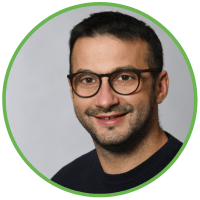Expanding the AAV analytical toolkit for gene therapies

The development of recombinant adeno-associated virus (rAAV) vectors has revolutionized gene therapy, offering promising treatments for previously untreatable genetic disorders. However, the journey from laboratory concept to clinical application presents numerous analytical and production challenges that must be overcome to ensure safety, efficacy and consistency.
In this interview, we spoke with Stefano Boi to learn how some of these challenges can be addressed. With a focus on analytical methods, quality control, and process optimization, Stefano offers valuable insights into the complexities of rAAV development and the innovative approaches being implemented to enhance vector yield while maintaining rigorous quality standards.
 Stefano Boi
Stefano Boi
Manager, Viral Vector development
Cellca (Ulm, Germany)
Stefano Boi is Manager of Viral Vector Development within the Cell Line, Media & Testing Solutions team at Sartorius in Ulm, where he has led efforts over the past four years to advance AAV production platforms. Prior to joining Sartorius, he was a Research Fellow at the National Institute for Bioprocessing Research and Training (Dublin, Ireland) focusing on the optimization and characterization of AAV production in HEK and Sf9 cells. He also spent five years as a Postdoctoral Fellow at the Rocky Mountain Laboratories, NIH (Montana, USA), studying mouse retroviruses. Dr. Boi earned his PhD in antiviral drug development from the University of Cagliari (Italy) in 2014.
- What are the most significant analytical challenges you face when developing lab-scale rAAV production processes?
- How do you approach the characterization of empty versus full capsids during development, and what analytical methods have you found most effective?
- Could you discuss the critical quality attributes you monitor during rAAV production and how these translate to therapeutic efficacy?
- What strategies have you implemented to improve vector yield while maintaining consistent quality profiles?
- How has the toolkit for rAAV characterization evolved in recent years, and which innovations have had the most significant impact on your work?
- Could you share insights on how you validate novel methods for rAAV quality assessment?
- How do you balance the need for rapid analytical turnaround with the requirement for comprehensive characterization during development?
- What data do regulatory agencies typically focus on when reviewing rAAV production processes?
What are the most significant analytical challenges you face when developing lab-scale rAAV production processes?
From an upstream perspective, the initial assay to establish involves measuring the viral genome and capsid titer, along with assessing the potency of the viral particle. The focus at this stage is on determining the titers in the crude lysate, which can lead to matrix effects from the lysis buffer. The method used for the viral genome can introduce significant bias; for instance, qPCR is more susceptible to matrix effects, and insufficient digestion of plasmid residues or ITR-based measurements can inflate titers. Digital (d)PCR devices now offer higher sensitivity despite higher sample dilution and endpoint-based analysis, making them less prone to matrix effects and easier to set up.
However, the main challenge remains the availability of standard materials, which are typically quantified by qPCR and are costly, along with the removal of DNA not packaged into viral particles. Additionally, depending on the primer probe design, quantification may not differentiate between full and partial genome-filled capsids, as the measured sequence represents only a fraction of the necessary packaged genome. Overinflation of viral titer due to various genome truncation patterns can vary significantly.
For capsid titer measurement, several possibilities can be evaluated, but no gold standard has been established. ELISA-based methods exist, but the assay variance is relatively high, especially in crude lysates. BLI-based systems, like the AAVX kit for the Octet, provide reliable results for higher titer and both crude and purified samples.
The primary challenge remains quantifying transducing units. Currently, the gold standard involves using a special HeLa cell line co-infected with rAAV and an Adenovirus 5 standard in serial dilution, analyzing genomic copies. However, co-infection with an infectious standard virus is undesirable. Using HEK or other cells for a GFP or other reporter transgene with FACS works only for non-clinical transgenes, limiting the serotypes that can be measured. A universal transducible cell line or cell line kit and a method to detect full cargo delivery into the reporter cell, would be highly beneficial.
How do you approach the characterization of empty versus full capsids during development, and what analytical methods have you found most effective?
We work with crude lysate and finding a determination method that allows a single device to assess full and empty particles in unpurified samples remains challenging. The main difficulty lies in determining capsid numbers with low standard deviation between biological replicates, a wide titer range, and high sensitivity even in crude samples, while allowing high throughput. Currently, we determine the viral genome via ddPCR and capsid titer with ELISA or the Octet/AAVx kit, with the full-empty ratio being a numeric ratio of these measurements. We are exploring alternatives, but the field is still evolving.
Could you discuss the critical quality attributes you monitor during rAAV production and how these translate to therapeutic efficacy?
Capsid content versus empty-full, potency, and purity are crucial quality attributes during production. The absolute number of empty capsids, the full/empty ratio, and the potency of rAAV vectors directly impact therapeutic efficacy. Only full capsids deliver the intended genetic material, while potency determines how many cells are transduced and receive the full genome. In rAAV, the number of potent particles versus at least partially filled particles remains low. Purifying truly potent particles, not just filled ones, would improve therapeutic side effects related to immune responses to ineffective particles and reduce the capsid dose. Therefore, identifying parameters for very potent and full particles during process development is essential. We have observed that plasmid genetic makeup and transfection reagents have the most significant effects in this regard, although the cell line and even feeds also play a major role.
What strategies have you implemented to improve vector yield while maintaining consistent quality profiles?
There are multiple strategies to improve vector yield. Initially, it is crucial to have a robust cell line with a suitable growth medium for production. We have found that the interplay between plasmid system/design and transfection reagent offers the greatest potential for yield improvement. Understanding the biology of rAAV replication and the many involved factors allows for designing better plasmids that respond more stably in terms of quality while still improving yield. Switching the cell line can significantly impact transgene-to-transgene or serotype predictability (yield, etc.), even if everything else remains the same. Plasmid ratios are often tested for yield improvement, and a strong, unclear effect plays a role here depending on the transfection reagent, which must be addressed by better understanding the transfection process and the biology of the components. Using enhancers can help with yield but can be very transgene or cell line specific. Having a high-quality purification and downstream analytic setup is crucial to understanding the quality impact of a new process on the drug substance. When establishing a new process, it is important to evaluate different parameters like plasmid system and amount, transfection reagent, and cultivation conditions. Optimization of transfection protocols is vital to improve transfection efficiency, increase vector yield, and influence potency. Cell line engineering is an alternative way to directly improve rAAV production.
How has the toolkit for rAAV characterization evolved in recent years, and which innovations have had the most significant impact on your work?
The toolkit for rAAV characterization has evolved significantly in recent years. New detection methods using high-resolution mass spectrometry provide detailed analysis of capsid proteins and post-translational modifications. Additionally, a device using mass photometry allows faster rAAV empty-full characterization. Next-generation sequencing (NGS) offers more detailed characterization of produced viral genome length and purity. In upstream work, implementing ELISA-based methods on high-throughput devices like the Octet has greatly improved throughput for fast determination of capsid titer in crude lysate. Additionally, implementing dPCR provides a much more accurate and robust value of viral genomes compared to qPCR.
Could you share insights on how you validate novel methods for rAAV quality assessment?
In our lab we focus on cell line development, and it is important for us to compare our yield with the market standards. Performance of the cells is our success criteria and in order to evaluate that rAAV quantification is essential. Novel method evaluation and validation for rAAV quality assessment involves ensuring robustness and reproducibility across different batches and conditions. Comparative studies are conducted to benchmark new methods against established standards, ensuring they provide reliable and accurate results. Regulatory compliance is also a key consideration, aligning validation processes with regulatory guidelines to ensure that the methods meet industry standards and can be used in production.
How do you balance the need for rapid analytical turnaround with the requirement for comprehensive characterization during development?
During development, high sample numbers are screened, and one key to rapid turnaround is implementing automation systems. In our lab, we have set up high-throughput screening using the TECAN, allowing the screening of multiple clones in small-scale plates. rAAV production and analysis are still done manually, but we aim to implement automation for potency and ddPCR sample preparation. Prioritizing key attributes is essential, focusing on the most critical attributes for rapid assessment while ensuring comprehensive characterization is achieved.
What data do regulatory agencies typically focus on when reviewing rAAV production processes?
Regulatory agencies typically focus on data related to safety and efficacy, including purity, potency and stability profiles. As we focus on cell line development, we strictly monitor the history of the cell line that will become the base component for therapeutic manufacturing. Each material and step should be documented and reviewed. Manufacturing consistency is another key area, demonstrating that production processes are reliable and produce consistent results. Comparative studies are also important, providing data that compares new processes to established benchmarks, ensuring the production methods meet regulatory standards and can be approved for therapeutic use. The quality of genetic constructs used in the process, in terms of thorough characterization, is very important. This requires careful selection and combination of elements used in genetic design. Any materials in the process must be available as cGMP grade, removable during purification, or be of no concern for severely ill patients.
The opinions expressed in this interview are those of the interviewee and do not necessarily reflect the views of Bioanalysis Zone or Taylor & Francis Group.
In association with:

